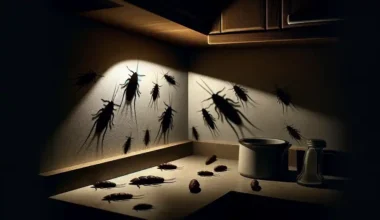Usually, cockroach smear marks can be found in areas with high moisture. These marks are dark, irregular shaped cockroaches leave as they crawl along walls or even when they rest. If you find smear marks from roaches, you want to quickly get rid of them, as well as the roaches since it indicates an infestation.
What Are Cockroach Smear Marks?

Cockroach smear marks are marks produced as the cockroaches crawl over various surfaces, leaving behind a track of their feces and body secretions. These trails provide a physical manifestation of their presence and serve as a major red flag for homeowners, pest control professionals, or property managers.
The smear marks from roaches are typically dark in color, brown or black, and they can range in appearance from small dots to irregular lines. The specific appearance depends largely on the level of infestation and the type of cockroach. For instance, larger cockroaches often leave more visible smudge-like markings, while smaller ones may leave more dotted trails. The marks can be found on both vertical and horizontal surfaces as cockroaches have the unique ability to crawl on walls and even ceilings.
A key factor that influences the production of smear marks is the level of moisture in the environment. Cockroaches prefer damp and humid conditions, and when traversing such areas, their feces can form a paste-like substance. This paste can be smeared along their paths, creating the distinctive marks associated with their activity.
Where Roaches Leave Their Smear
Smear marks are often located near food sources, hiding places, or along common routes that cockroaches take in their daily activities. These can include behind furniture, in corners of rooms, inside cupboards and cabinets, and along pipes or wiring.
This tendency to follow established routes is due to the cockroach’s thigmotactic nature – their preference to navigate by maintaining contact with the edges of their environment.
Besides serving as an unpleasant sign of infestation, smear marks can also be harmful. Cockroach feces, which constitute the bulk of these marks, can carry harmful pathogens. When these are deposited on surfaces, especially those involved in food preparation or consumption, they pose a significant risk of foodborne illnesses.
Roach Smear Smell
Cockroach smear marks, also known as roach feces, have a distinct odor that can become particularly noticeable in cases of severe infestations.
This smell is often described as musty, oily, or like ammonia. The scent serves a communication purpose for cockroaches, attracting others to join their congregation or signaling potential danger.
Over time, the odor can permeate into fabrics, wallpaper, and other porous materials, making it difficult to eliminate. The smell can contribute to allergic reactions in sensitive individuals and worsen asthma symptoms.
Does Cockroach Smear Attract Other Roaches?
Cockroaches, like many other insects, are highly social creatures that rely on a variety of signals to communicate with each other. One such communication method is through the use of chemical cues, known as pheromones, which are found in their feces or cockroach smear marks. These smear marks not only indicate a roach’s presence but also serve as a means to attract other cockroaches. Understanding this process can provide valuable insights into their behavior and inform effective control strategies.
When a cockroach moves through an environment, it leaves a trail of feces and other secretions that comprise the smear marks. These trails contain aggregation pheromones, specific chemical signals that encourage other roaches to gather. The presence of these marks signals to other cockroaches that a location is safe, contains food sources, or is suitable for nesting.
Cockroaches of the same species are drawn to these trails, using them to find food, mates, and suitable habitats. They can discover established colonies, potentially joining them and contributing to the growth of the infestation. It is particularly useful for young cockroaches or nymphs, who are less familiar with their environment and rely heavily on these trails to find resources and avoid danger.
However, these pheromone trails aren’t just a beacon for roaches looking for food or shelter. The pheromones found in roach feces can also act as a mating call, attracting cockroaches of the opposite sex. Male cockroaches produce sex pheromones that female cockroaches find irresistible – PubMed Central.
How to Clean Cockroach Smear
Cockroach smear marks are a telltale sign of an infestation and a constant reminder of the nuisance and health risk these pests pose. Follow these steps to clean cockroach smear in your home:
| Step | Description |
|---|---|
| Assessment | Conduct a thorough assessment to locate all areas with roach smear marks. Pay special attention to hidden and hard-to-reach areas. Use a flashlight to see clearly in darker areas. |
| Safety Preparations | Ensure personal safety during the cleaning process. Wear a mask to avoid inhaling dust particles and allergens. Wear disposable gloves to prevent direct contact with smear marks. Consider wearing old clothes that can be washed immediately after cleaning. |
| Surface Cleaning | Use a vacuum cleaner with a HEPA filter to remove loose debris and dust. Prepare a cleaning solution of warm water and mild detergent. Apply the solution using a sponge or cloth to marked areas. Scrub gently but thoroughly. Rinse the sponge or cloth frequently. |
| Disinfection | After initial cleaning, disinfect the surfaces. Mix one part bleach with ten parts water. Apply the solution to cleaned areas. Leave it on for 10-15 minutes, then rinse with clean water and dry surfaces thoroughly. Use bleach in a well-ventilated area and avoid mixing with other cleaners, especially those containing ammonia. |
| Deep Cleaning | For porous surfaces like fabric or upholstery, consider professional cleaning services or rented steam cleaners for a more thorough cleaning and disinfection. |
| Preventive Measures | Take preventive measures to avoid future infestations. Seal cracks and crevices, maintain cleanliness in the kitchen and bathroom, and store food in airtight containers. Regularly monitor your home for signs of roach activity. |
| Professional Help | Seek professional help if the infestation is severe or if you are unsure about how to handle it. Pest control services can provide expertise, equipment, and advice on preventing future problems. |
| Follow-up Actions | Regularly clean and monitor previously infested areas, even after the infestation appears to be under control. Cockroaches are resilient, and a small overlooked population can lead to a resurgence. |
Cockroach Smear Marks on Walls
Cockroach smear marks on walls are a common indicator of a roach infestation. Cockroaches are nocturnal creatures that hide during the day and become active at night. As they travel in search of food and water, they often leave behind smear marks, especially along walls and other vertical surfaces that they frequently traverse.
Cockroach smear marks are essentially a trail of feces and other secretions left by these pests. Their appearance can vary, from tiny specks to smudged lines, largely dependent on the species and size of the cockroach. The color typically ranges from brown to black. The marks are more likely to smear and become prominent in areas of high moisture, given that cockroach droppings can turn into a paste-like substance in damp conditions.
Identifying these marks on your walls is typically the first step in addressing a roach problem in your walls. These marks tend to appear behind furniture, in corners, near food sources, or along the routes that roaches commonly take. You might notice them along the edges of the room or behind appliances. If these signs are noticed, it’s a clear signal that immediate action is needed.
While these smear marks are unsightly and can contribute to a foul smell, their impact goes beyond aesthetics. The feces within these marks can contain harmful pathogens that pose a health risk, especially when deposited on surfaces involved in food preparation or consumption.
Is Cockroach Smear Dangerous?
Allergies
The allergens produced by cockroaches can trigger allergic reactions in some people. Symptoms can include itchy skin, watery eyes, sneezing, and in severe cases, difficulty in breathing.
Asthma
In individuals with asthma, especially children, cockroach allergens can provoke asthma attacks or exacerbate the symptoms. In fact, some research suggests that exposure to these allergens is one of the major risk factors for asthma in inner-city homes.
Spread of diseases
Cockroaches can spread various types of bacteria, like Salmonella and E. coli, that can cause gastrointestinal illnesses. Although these diseases aren’t caused by the cockroach smear itself, they can be transmitted when people come into contact with surfaces contaminated by cockroaches.
Parasites
Cockroaches can carry parasitic worms which can be harmful to humans.
Read also: Can I Break My Lease Because of Roaches in Texas?






